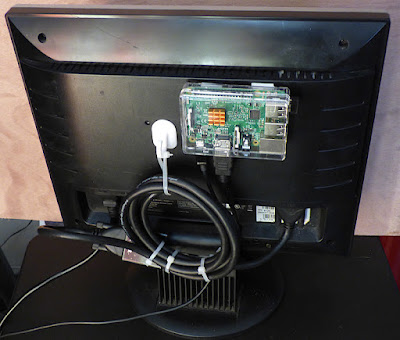The Pi was attached to the back of a monitor to make the rig portable and the cables tidied up with cable ties and an adhesive hook. The Pi had a CPU heatsink and a 1 Amp power supply was used.
At this stage a reminder of the relevant specifications of the Raspberry Pi 3b computer is in order:
CPU: 4× ARM Cortex-A53, 1.2GHz
GPU: Broadcom VideoCore IV
RAM: 1GB LPDDR2 (900 MHz)
A powered hub was used to connect a DMK 21AU04.AS camera to one of the 4 USB ports of the Pi and a Bluetooth Keyboard and mouse were connected to another port.
AstroDMx Capture for Linux, compiled for the Pi was loaded and launched. The DMK was placed at the prime focus of an f/5.5, 80mm, ED refractor on an iOptron Cube Pro, AZ, GOTO mount. 100 x 8s exposure TIFF files were captured of M17 and of M13. Matching darkframes were also captured. The images were de-rotated, dark-frame corrected and stacked with lxnstack. The resulting images were post processed in the Gimp 2.9.
The capture kit in action
Screenshot of AstroDMx Capture for Linux running on the Pi and capturing images of M13
M13
M17, the Swan or Omega nebula
Further experiments are planned with a 3 Amp power supply and a case with a built in fan plus heat sinks for the CPU and the GPU.
It is clear that the Raspberry Pi can be used as a serious astro-imaging computer. We shall perform experiments to maximise its performance although at the moment, the Pi has no problem sustaining a 30 fps frame-rate.
2000 frame SER files were captured of the Moon, they were stacked in Autostakkert! 2.6 in Wine, stitched in Microsoft ICE in Wine 2.5, wavelet processed in Registax 5.1 in Wine and post processed in the Gimp 2.9.
Screenshot of AstroDMx Capture for Linux running on the Pi capturing a Lunar SER file
The Lunar, 2 pane mosaic






